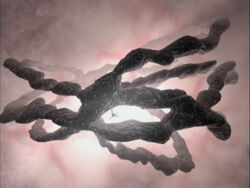Kalen Rann (talk | contribs) |
Blind Wolf (talk | contribs) m (→Side Effects) |
||
| Line 25: | Line 25: | ||
===Side Effects=== |
===Side Effects=== |
||
| − | ''Hyperspace Travel Syndrome'', or "''HST''" is a common affliction among long range interstellar pilots. [[Catherine Sakai]] |
+ | ''Hyperspace Travel Syndrome'', or "''HST''" is a common affliction among long range interstellar pilots. [[Catherine Sakai]] was known to suffer from this Syndrome. |
Symptoms include nausea, vertigo, and panic attacks, including an overwhelming feeling of motionlessness. It is caused by long term exposure to the conditions of hyperspace in which the view outside the cockpit windows of a space craft give the pilot the impression that the apparent motion of the craft is not the actual motion as the craft’s instruments would indicate. This combined with the disorienting effects of the constantly flickering and shifting patterns of light and false shadow over time begin to play tricks on the brain, scrambling perceptions of up and down, forward and backward. Some pilots even say it's like being caught in a dream or nightmare from which one could not awaken. |
Symptoms include nausea, vertigo, and panic attacks, including an overwhelming feeling of motionlessness. It is caused by long term exposure to the conditions of hyperspace in which the view outside the cockpit windows of a space craft give the pilot the impression that the apparent motion of the craft is not the actual motion as the craft’s instruments would indicate. This combined with the disorienting effects of the constantly flickering and shifting patterns of light and false shadow over time begin to play tricks on the brain, scrambling perceptions of up and down, forward and backward. Some pilots even say it's like being caught in a dream or nightmare from which one could not awaken. |
||
Revision as of 20:40, 20 October 2009

Fen in Hyperspace
Hyperspace is an alternate dimension which is used for speedy travel between locations that would otherwise take longer to travel to in normal space. The entire dimension appears as a stormy environment that has a constant red hue.[1]
Hyperspace Travel
Jump Points

An incoming jump point begins to form

An incoming jump point opens
Transit between normal space and hyperspace occurs through the use of a 'Jump point'. A Jump point is a large energised vortex that punches a hole between the dimensions and allows objects to pass from one side to the other. To do this requires a huge amount of energy and so most hyperspace travel is achieved via a Jumpgate, though Starships that can meet the energy requirements can generate their own Jump points with use of on-board Jump Engines.[2]
Jump points are strictly one way and outgoing points are distinguished by a red-shift, while incoming jump points posses a blue-shift. If for instance one jump point is opened inside of another, the staggering release of energy would almost instantly cause an enormous explosion. During the Earth-Minbari War, Earthforce briefly experimented with the offensive applications of this tactic though quickly dubbing it the "Bonehead Maneuver", as none of the Earthforce ships were able to clear the blast radius before being destroyed.[3][4]
Jump points do however have other tactical uses in warfare. A notable Minbari tactic is to lure an enemy fleet or task force into a predetermined location and then open a jump point right in their midst. Any ship that makes contact with the outer edge of the vortex is either instantly destroyed or severely crippled and the remaining ships are caught by surprise and easy targets for the Minbari Cruiser that has just jumped into the middle of them. During the Earth-Minbari War, the Drala Fi used this tactic to devastate the task force lead by the EAS Lexington.[5]
For safety reasons, jump points are normally opened only in deep space, away from any potential navigational hazards though with sufficiently accurate targeting information it is possible to open a jump point within, and safely transit into, a planetary atmosphere.[6] However, due to the massive release of energy involved, doing so in a highly combustible atmosphere will cause a suitably large explosion and shock wave.[7]
Since most of the younger races all based their hyperspace technology off of the ancient Jumpgates left behind by an unknown race, they all bare the same characteristics, however Shadow vessels and other First Ones have been observed entering and exiting hyperspace without the normal whirlpool being present. Shadow Vessels appear to "phase" in and out, though the energy readings register on sensors as being consistent with the forming of a normal jump point. The Walkers of Sigma-957 open a very large point which can only be described as being visually similar to arc lightning and has been known to almost completely drain the power from any ship caught in it's wake while other First Ones appear to use some variation of phasing or emerging from a burst of light, except for the Vorlons, who have been consistently observed to use the same vortex technology as the younger races.[8][9][10][11]
The Beacons
The beacon network was set up by the younger races as a way to navigate the perilous and constantly shifting nature of hyperspace and consists of a series of tachyon beams connecting two points - usually jumpgates - together so that ships can follow the beacons from one point to the next and thus navigate to their ultimate destination.[12] Ships that travel off the beacon and loose the lock-on signal are generally lost forever, however rescue effort can be made by having a chain of ships maintaining a lock-on signal with each other, with one remaining on the beacon to act as anchor while the others extend out into open hyperspace. Timing is crucial as the longer a ship is off the beacon the further away it will drift and the less likely it is for a rescue chain to locate it.[13] The Thirdspace artifact, discovered in 2261 having been abandoned in hyperspace over a million years prior, when it drifted near enough to the beacon network to be noticed was retrieved using the "chain of ships" technique.[14] Races and groups with access to more advanced technology need not depend on the beacons at all, for example the Technomagess are the masters of hyperspace navigation and can travel completely off the beacon by and amplifying even the weakest signal to usable form.[15] The Vorlons have been observed folding a piece of hyperspace onto itself and create a pocket for their vessels to hide in, allowing huge fleets to travel almost undetected.[16]
Most ships that travel in hyperspace have a built in fail-safe that automatically shuts down the sublight engines if the computer fails to receive a given command during a predetermined period of time. This guards against a ship drifting too far off the beacon in the event that the crew are incapacitated or killed and increases the chances of the ship being found and rescued by a passing vessel.[17]
Side Effects
Hyperspace Travel Syndrome, or "HST" is a common affliction among long range interstellar pilots. Catherine Sakai was known to suffer from this Syndrome.
Symptoms include nausea, vertigo, and panic attacks, including an overwhelming feeling of motionlessness. It is caused by long term exposure to the conditions of hyperspace in which the view outside the cockpit windows of a space craft give the pilot the impression that the apparent motion of the craft is not the actual motion as the craft’s instruments would indicate. This combined with the disorienting effects of the constantly flickering and shifting patterns of light and false shadow over time begin to play tricks on the brain, scrambling perceptions of up and down, forward and backward. Some pilots even say it's like being caught in a dream or nightmare from which one could not awaken.
It is because of HST syndrome that many passenger ships do not have windows in the passenger compartments, or close them during travel through hyperspace. A pilot however, cannot risk flying blind given the dangers inherent in hyperspace travel. So it is necessary for a ship’s flight crew to learn to live with the side effects, train their eyes to see past the optical illusions and trust their instruments.[1] Hyperspace has also been found to enhance telepathic power and range, though in the case of humans, this particular ability was kept quiet by Psi Corps - at least until it's disillusion - lest the military start posting telepaths on the front lines. Ironically, following the Telepath War and the integration of telepaths back into human society and Earthforce, that is exactly what happened.[18][15]
Hyperspace Combat
Engagements in hyperspace are rare and most often avoided by all parties as such battles have often turned out to be disasters in the past. Aside from the dangers inherent with hyperspace travel, the unpredictable spatial knots and gravitational inclines can cause missiles and even energy weapons to bend off course, either missing the target entierly or even strike a friendly ship. As such, what little fighting in hyperspace does take place is usually one-on-one over a very short range and often strictly hit-and-run strikes. Sometimes using small groups of fighters and/or smaller warships as large fleet engagements are out of the question.[19][1][20][21]
Fauna
The Fen, a species of huge jellyfish like creatures. The existence of creatures living in hyperspace had long been rumored among some species, but never confirmed by Humans, until 2267 when the Excalibur encountered a swarm en route to the Well of Forever. They are barely sentient, generally attracted to bright shiny objects. Though the Fen are not overtly hostile and there are no known accounts of one ever consuming a Starship, they may attempt to couple with one.[22][15]
Points of Interest

The Well of Forever when found in 2267 by the Excalibur.
In 2267 the Excalibur re-discovered the Well of Forever with the help of the Technomage, Galen.[15]
See Also
References
- ↑ 1.0 1.1 1.2 To Dream in the City of Sorrows
- ↑ JMS post on rec.arts.sf.tv.babylon5.moderated - 7/9/1993 4:22:00 PM
- ↑ Matters of Honor
- ↑ JMS post on CIS - 3/26/1996 5:11:00 AM
- ↑ In the Beginning
- ↑ Endgame
- ↑ Messages from Earth
- ↑ Shadow Dancing
- ↑ Mind War
- ↑ Into the Fire
- ↑ Thirdspace (movie)
- ↑ JMS post on AOL - 4/3/1996 6:21:00 PM
- ↑ A Distant Star
- ↑ Thirdspace (movie)
- ↑ 15.0 15.1 15.2 15.3 The Well of Forever
- ↑ The Summoning
- ↑ Genius Loci
- ↑ Epiphanies
- ↑ Endgame
- ↑ A View from the Gallery
- ↑ Ship of Tears
- ↑ A Distant Star
